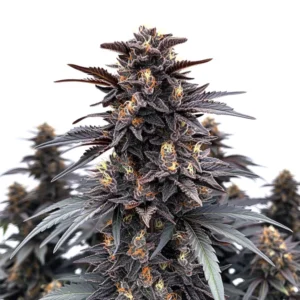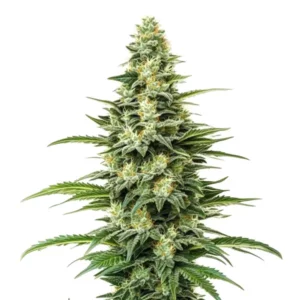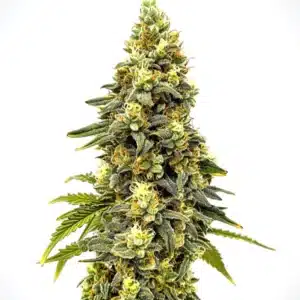
Growing Critical Auto Outdoors: Maximize Your Yields
If you’re ready to take your cannabis cultivation to the next level, growing Critical Auto outdoors might be the perfect solution. This strain offers the fast-flowering and high-yield potential of Critical with the resilience of an autoflower, making it ideal for outdoor cultivation. In this article, we’ll guide you through everything you need to know about successfully growing Critical Auto outdoors, with a focus on optimizing your grow in European climates.
Why Grow Critical Auto Outdoors in Europe?
Europe offers a variety of climates, from the Mediterranean warmth to the cooler Northern regions, and growing cannabis outdoors in these environments has its benefits. But why choose Critical Auto? Let’s look at the advantages and the rising popularity of autoflowering strains across the continent.
Recommended Strains
Critical Auto
-
THC: 10% - 14%
-
Type of seed: Autoflowering
-
Phenotype: 30% Sativa / 70% Indica
-
Flavor: Herbal, Lemon, Woody
-
Life cycle of: 8 - 10 weeks
Critical 2.0 Auto
-
THC: 18% - 20%
-
Type of seed: Autoflowering
-
Phenotype: 40% Sativa / 60% Indica
-
Flavor: Citrus, Skunk
-
Life cycle of: 10 - 12 weeks
Advantages of Growing Critical Auto
Critical Auto is an excellent strain for outdoor cultivation due to its autoflowering properties. Unlike photoperiod plants, autoflowers automatically switch from the vegetative phase to flowering after a certain period of time, typically around 2 to 3 weeks. This means Critical Auto is not dependent on light cycles, allowing it to thrive in outdoor conditions where daylight hours vary throughout the year.
One of the biggest advantages of growing Critical Auto outdoors is its rapid growth cycle. With a short life span of about 10 weeks from seed to harvest, this strain allows multiple harvests in a single season, making it a great choice for growers looking to maximize yields. Moreover, it’s highly resilient to environmental stress, pests, and mold, which makes it perfect for unpredictable European weather.
Popularity of Autoflowering Strains in Europe
Autoflowering strains like Critical Auto have surged in popularity in Europe, especially among outdoor growers. The ability to grow multiple crops in one season, combined with the plants’ smaller stature, makes them ideal for discreet outdoor cultivation. Autoflowers also perform well in regions with shorter summers, as they don’t require long periods of intense sunlight to flower.
In countries like Spain, Italy, and Portugal, growing Critical Auto outdoors has become a favored option due to the warm, sunny climate that allows for two or even three harvests in a single growing season. For those in northern regions like the UK or the Netherlands, Critical Auto’s fast flowering time makes it a reliable choice, even in cooler climates with shorter growing seasons.
Promos & Deals
Climate and Conditions for Growing Critical Auto in Europe
When it comes to growing Critical Auto outdoors, understanding the climate is essential. Europe’s diverse weather patterns can greatly impact the success of your grow, so tailoring your approach to your region is crucial.
Best Regions for Growing Critical Auto in Europe
Europe’s warmer southern regions, including Spain, Portugal, and Italy, are ideal for growing Critical Auto outdoors. These areas benefit from long, sunny summers, allowing the plants to thrive with minimal intervention. In these Mediterranean climates, Critical Auto’s fast growth cycle means you can plant multiple crops from spring to fall, maximizing your harvest potential.
For growers in more temperate regions, such as France, Germany, and the UK, Critical Auto is still a great option. Its short life cycle means you can avoid the cooler autumn months, which can often bring rain and lower temperatures that increase the risk of mold and mildew. With a little preparation, even those in northern Europe can enjoy bountiful harvests by choosing the right planting times.
Ideal Temperatures and Weather Conditions
Critical Auto thrives in temperatures ranging from 18°C to 26°C (65°F to 80°F). Consistent warm weather helps the plant grow quickly and produce dense, resinous buds. In southern Europe, these temperatures are common during the growing season, making it easy to grow Critical Auto without the need for much intervention.
However, for growers in cooler climates, you may need to take extra precautions to protect your plants. Planting in late spring or early summer ensures that your plants will receive plenty of sunlight during the warmest months. Avoid planting too late in the season to prevent your plants from being exposed to cold nights and frosty conditions.
Managing Rain and Humidity
Rain and humidity are critical factors when growing Critical Auto outdoors. While Critical Auto is relatively mold-resistant, prolonged exposure to high humidity can still lead to problems like bud rot. This is especially true in regions like the UK, the Netherlands, and parts of Northern Europe, where rain and damp conditions are common.
To combat these issues, choose well-drained planting areas and avoid watering directly on the leaves and buds. Consider planting in pots or raised beds to improve drainage and reduce the risk of waterlogging. Additionally, spacing your plants out ensures good airflow, which helps reduce humidity around the plants. If your area is prone to rain, consider using a simple rain cover or greenhouse to protect your plants during heavy downpours.
Preparing Your Outdoor Grow Space
The key to growing Critical Auto outdoors successfully is creating the perfect grow environment. This involves choosing the right location, preparing the soil, and ensuring proper drainage to support rapid and healthy growth.
Choosing the Right Location
When selecting a location for your outdoor grow, prioritize areas that receive plenty of direct sunlight throughout the day. Critical Auto needs a minimum of 6 hours of sunlight per day to reach its full potential, though 8 to 10 hours is ideal. Look for a spot in your garden or outdoor space that is sheltered from strong winds but still receives good airflow.
For growers in regions with cooler or unpredictable weather, consider using a greenhouse or poly-tunnel to give your plants extra protection from the elements while still taking advantage of natural sunlight. These structures can also help extend the growing season by keeping temperatures more consistent.
Soil Preparation and Nutrient Needs
Soil quality plays a crucial role in the success of growing Critical Auto outdoors. Autoflowers like Critical Auto perform best in light, well-aerated soil that allows the roots to breathe. If your soil is heavy or clay-based, mix in perlite, coco coir, or sand to improve drainage and aeration.
Critical Auto doesn’t require heavy feeding, but it still needs the right nutrients at each stage of growth. Start with a nutrient-rich soil mix, and supplement it with organic fertilizers or compost. During the vegetative stage, nitrogen is essential for promoting healthy leaf growth. As the plant enters the flowering phase, switch to a bloom fertilizer rich in phosphorus and potassium to support bud development.
Ensuring Proper Drainage and Aeration
One of the biggest challenges with growing Critical Auto outdoors is ensuring that your plants don’t suffer from waterlogged soil. Good drainage is key to preventing root rot, especially in regions with frequent rainfall. When preparing your outdoor grow space, make sure the soil drains well by testing it with water before planting.
If you’re growing in pots, use containers with drainage holes, and place them on a surface that allows excess water to escape. For ground-grown plants, raised beds are a great option, as they allow for better drainage and root aeration. Adding organic matter like compost to your soil also helps improve its structure and promotes healthy root growth.

Planting Critical Auto Outdoors
Once you’ve prepared your grow space and ensured that the conditions are just right, it’s time to plant your Critical Auto seeds or transplants. Understanding the best time to plant and proper spacing techniques is key to maximizing your outdoor grow’s potential.
When to Plant Critical Auto Outdoors in Europe
Timing is critical when planting cannabis outdoors, and it’s no different with growing Critical Auto outdoors in Europe. Since Critical Auto is an autoflowering strain, it is not dependent on the light cycle to flower, which means you have more flexibility with planting times. However, for the best results, you should plant when temperatures are consistently warm.
In Southern Europe, where the climate is warmer and more stable, you can start planting as early as late April or early May. This gives your plants enough time to grow and flower during the long sunny days of spring and summer. In cooler regions like Northern Europe, it’s best to wait until late May or June, once the danger of frost has passed and the temperatures are more reliable.
Because Critical Auto has a short life cycle of 8-10 weeks, you can plant multiple rounds of crops throughout the summer. This gives you the opportunity to harvest several times within a single growing season, making the most of the warmer months.
Starting with Seeds or Transplants
When it comes to growing Critical Auto outdoors, you can either start from seeds or use transplants. Starting from seeds is often the most cost-effective and preferred method for autoflowers. If you choose this route, make sure to germinate your seeds indoors in a controlled environment before transplanting them outdoors. Place the seeds in a damp paper towel or directly into a starter pot and keep them in a warm, sunny spot to encourage quick germination.
Once the seedlings have developed a healthy root system and a few sets of leaves, they can be transplanted outdoors into your prepared grow space. Transplanting should be done carefully, as autoflowering strains are more sensitive to transplant shock than photoperiod plants. Be sure to transplant during the cooler parts of the day to avoid stressing the young plants.
Alternatively, some growers prefer to buy young transplants from a nursery or fellow growers. This method is ideal for those who want a head start and reduce the germination phase. Just be sure that the transplants are healthy and hardened off (gradually exposed to outdoor conditions) before moving them to their permanent location.
Spacing and Planting Depth Guidelines
Proper spacing and planting depth are essential for ensuring that your plants have enough room to grow and maximize light exposure. When growing Critical Auto outdoors, it’s recommended to space the plants at least 60 to 90 centimeters (about 2 to 3 feet) apart. This allows enough room for the plants to spread out, improves air circulation, and helps prevent mold or mildew.
If you’re planting directly into the ground, dig holes large enough to accommodate the root ball of your transplants, ensuring that the roots aren’t cramped. Plant the seedlings at the same depth they were in their starter pots, and gently firm the soil around the base to remove air pockets. If planting in containers, choose pots that are at least 10 liters (2.5 gallons) in size to allow the roots to expand.
Water the plants immediately after planting to help them settle into their new environment. Make sure to keep the soil moist, especially during the first few weeks of growth, to encourage healthy root development.
Caring for Critical Auto Plants Outdoors
Once your Critical Auto plants are in the ground or containers, your main focus will be on maintaining optimal growth conditions to ensure a successful harvest. Proper watering, feeding, and pest management are crucial components of a healthy grow.
Watering and Feeding Your Critical Auto
One of the most important aspects of growing Critical Auto outdoors is proper watering. Autoflowers tend to have smaller root systems than their photoperiod counterparts, so it’s important to water them consistently without overdoing it. Too much water can lead to root rot, while too little can cause stress and stunt growth.
During the early stages of growth, water your plants deeply about once a week, ensuring that the top few inches of soil are moist but not waterlogged. As the plants mature, especially during the flowering phase, increase watering frequency slightly, as Critical Auto plants tend to drink more as they develop larger buds.
Feeding is equally important to provide the nutrients that Critical Auto plants need throughout their life cycle. During the vegetative stage, nitrogen is essential for strong leaf and stem development. Use a balanced fertilizer or one with higher nitrogen content to support this phase. As the plants enter the flowering stage, switch to a bloom fertilizer high in phosphorus and potassium to promote bud development and maximize resin production.
If you prefer organic methods, consider using compost teas or natural amendments like bat guano and fish meal to provide your plants with the nutrients they need without harsh chemicals.
Pest and Disease Management in European Gardens
Outdoor grows are always susceptible to pests and diseases, and growing Critical Auto outdoors is no exception. Common pests like aphids, spider mites, and caterpillars can wreak havoc on your plants if left untreated. Regularly inspecting your plants for signs of infestation is key to catching problems early.
Use organic pest control methods like neem oil or insecticidal soap to keep pests at bay. Introducing beneficial insects like ladybugs and predatory mites can also help control pest populations naturally. If you notice small holes in leaves or sticky residue, act quickly to prevent further damage.
Diseases such as powdery mildew and bud rot can also be a concern, particularly in regions with high humidity or frequent rainfall. Ensuring good airflow around the plants by proper spacing and pruning helps prevent fungal growth. If you’re in a particularly humid area, consider using a fungicide or covering your plants during extended periods of wet weather to reduce the risk of mold.
Training Techniques for Better Yields
To get the most out of growing Critical Auto outdoors, implementing training techniques can help improve light exposure and increase your overall yield. Low-stress training (LST) is one of the most popular methods for autoflowers because it involves gently bending and tying down branches to create an even canopy. This allows more light to reach the lower parts of the plant, which encourages more bud sites to form.
Since Critical Auto has a short life cycle, it’s important to start LST early, usually within the first few weeks of growth, before the plant enters the flowering stage. Avoid high-stress training methods, such as topping, as autoflowers don’t have enough time to recover before flowering begins.
Regularly check your plants as they grow to make adjustments to the training, ensuring that all bud sites are exposed to optimal sunlight. With proper training, you can significantly boost your harvest without the need for additional plants.

















